It is essential to have a first aid kit for cats and dogs. Pets can have emergencies just like other members of the family. Having a first aid kit handy can really save the day!
If you don’t already have a first aid kit for your pet you can either purchase one or build one yourself. Purchasing a premade kit can cost anywhere from $15 to more than $100 depending on which one you choose and what is included in it.
To get the best pet first aid kit, building your own is often the right option. When you build your own kit you will have complete control over each item that goes into the kit and its quality. A first aid kit for cats and dogs will be similar to a first aid kit for humans, but there are some differences.
Here’s a look at what goes into a pet first aid kit and how to build a first aid kit for cats and dogs.
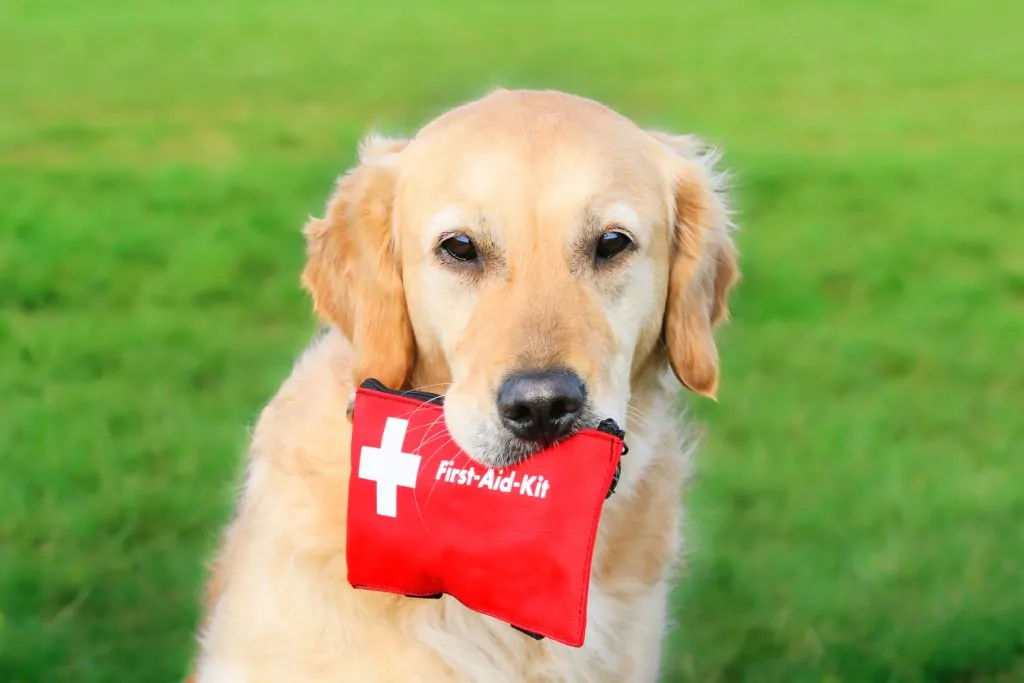
It is important to remember that an injured dog, even your best friend, can be volatile when in pain or scared. It is essential to have a soft muzzle to use in a dog first aid kit. This is necessary to have on hand even if your dog never needs a muzzle at any other time.
Additionally, you will want to stay away from any products that will stick to your dog’s fur, like self-adhesive gauze or bandages.
Here is a short list of things you will want to include when building a dog first aid kit:
To make the best first aid kit for cats, you will need to consider your own cat specifically. An injured cat may need to be restrained. Unlike a dog which only needs a muzzle, a cat's claws can become very dangerous. You will need a towel, small blanket, or thick pillowcase to help restrain the cat if necessary.
You may also want to consider an agent to stop bleeding in case your cat has an injury to its claw nail. This is especially true if you clip your cat’s nails at home.
Here is a short list of things you will want to include when building a dog first aid kit:
Since you are building this pet first aid kit, personalize it for your pet and specific situation. Consider building a larger kit if you have multiple pets. You may only include items for one type of animal, but if you have cats and dogs, you may want a kit that includes items for both.
Start by including items to restrain and comfort your pet like the soft muzzle, e-collar, and perhaps a soft absorbent cloth that can be used to dry them off or keep them warm.
Include wound care items like gauze, a roll of rubber strip to secure gauze, and a pet-safe wound wash. Tweezers and a magnifier might be needed to remove a thorn, stinger, or piece of glass.
You should include copies of your pet's vet records and any other official paperwork in the first aid kit. Use a water-tight container to keep any medicine your pet takes regularly that they might need in case of an emergency.
Being prepared for emergencies is part of keeping your family safe and pets are part of the family. If you need guidance about any of the items that should be included in your pet’s first aid kit seek guidance from your local veterinarian.
Puppy vaccines are one of the most important aspects of keeping your new friend safe and healthy as well as ensuring that they have a long life. There are so many things to keep straight when caring for a new puppy that which vaccines they need and when can become a bit confusing.
The following chart shows which vaccines your puppy will need as a general rule of thumb. However, it is important to remember that location, lifestyle, and your dog’s size and breed will all play a role in determining which vaccines they will need throughout their life. You will need to consult with your veterinarian to know exactly which vaccines your puppy will need and when to get them.
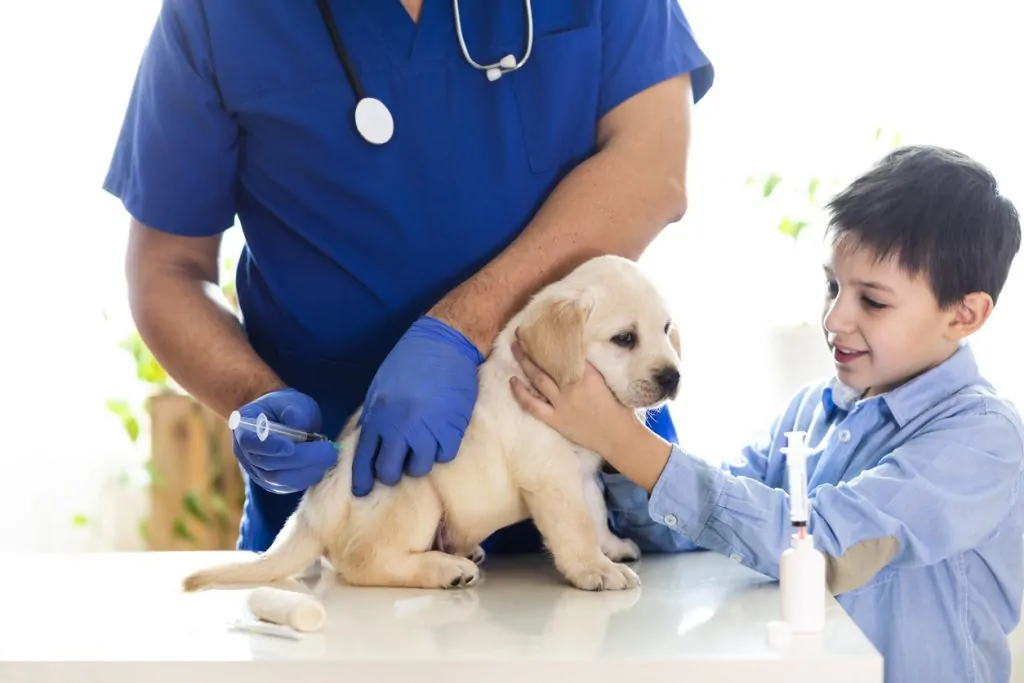
| Puppy’s Age | Recommended Vaccinations |
| 6 to 8 weeks | Distemper, parvovirus |
| 10 to 12 weeks | DHPP (vaccines for distemper, adenovirus [hepatitis], parainfluenza, and parvovirus) |
| 16 to 18 weeks | DHPP, rabies |
| 12 to 16 months | DHPP, rabies |
Distemper, parvovirus, DHPP, and rabies vaccines are recommended to keep your puppy healthy. There are additional vaccinations that you can ask for that are helpful but not absolutely necessary. As with all vaccinations, you will want to discuss the best option for your puppy with your local veterinarian.
| Puppy’s Age | Optional Vaccinations |
| 6 to 8 weeks | Bordetella |
| 10 to 12 weeks | Influenza, Leptospirosis, Bordetella, Lyme disease |
| 16 to 18 weeks | Influenza, Leptospirosis, Bordetella, Lyme disease |
| 12 to 16 months | Coronavirus, Leptospirosis, Bordetella, Lyme disease |
These are not vaccines that are required for every puppy. In many cases, they are a great idea and will protect your puppy from dangerous illnesses. Whether or not your puppy needs these specific vaccinations also depends on where you live and the type of lifestyle that you will lead with your dog. This is why it is so important to consult your veterinarian when deciding on the appropriate vaccination schedule for your puppy.
About a week after your puppy’s first round of shots it is okay to take them out in your own yard. That doesn’t mean they are ready to go play in the dog park and get social just yet, though.
After their second set of shots, you can take your puppy for walks on the sidewalk. They can also socialize with friendly dogs that you know are fully vaccinated.
After the third round of puppy shots, your puppy is ready to face the world and can go to a dog park. This is because they are now fully protected from the most likely puppyhood diseases.
If you have a new puppy, they are going to need to be properly vaccinated. That means getting the appropriate shots and boosters on the correct schedule. If you get off schedule by more than two weeks, your puppy’s immunity may suffer.
If you have a puppy that needs to be vaccinated, contact your local veterinarian right away to schedule an appointment.
As a pet owner, you want to do everything in your power to keep your furry friend safe and secure. One way to ensure that your pet can be quickly identified and returned to you if lost is by microchipping them. Microchipping is a safe, easy, and inexpensive way to give your pet permanent identification that can be used to track them back to you.

A microchip is a small, rice-sized device that is inserted under your pet's skin, usually between the shoulder blades. The microchip contains a unique identification number that can be read with a scanner. The microchip is registered with a database that holds your contact information, so if your pet is lost and found, they can be identified and quickly returned to you.
Pets are curious creatures and can easily wander off, especially if they are not kept in a secure area. Collars with identification tags are helpful, but they can fall off or be removed. Microchipping is a permanent way to identify your pet, even if they lose their collar.
Microchipping is also helpful for pets that are stolen. Unfortunately, pet theft is a growing problem, and pets that are not microchipped can be difficult to identify and retrieve. With a microchip, you increase the chances of being reunited with your furry friend if they are ever stolen. If you ever come across an animal with no owner present, please make sure to take it to a local vet or shelter where they can scan the animal for a microchip & successfully return the pet to its owner.
Another benefit of microchipping is that it can help settle ownership disputes. If your pet is lost and then found by someone else, the microchip can help prove that you are the rightful owner. This can be especially helpful in cases where pets have been lost for long periods of time, and their appearance may have changed.
Finally, microchipping is a requirement for some pet-related activities. For example, if you plan to travel with your pet overseas, some countries require a microchip as part of their import regulations. Microchipping is also necessary for some dog breeds to compete in shows.
The microchipping process is quick and painless. The device is inserted with a needle, and your pet may feel a small pinch, similar to getting a vaccine. Once the microchip is inserted, it is registered with a database, which includes your contact information.
It is essential to keep your contact information up to date in the database. If you move or change your phone number, make sure to update the database as soon as possible. This ensures that if your pet is lost, you can be easily contacted.
Microchipping is a simple way to provide your pet with permanent identification that can help them be quickly returned to you if lost. It is a safe and inexpensive procedure that can be done at your vet's office. With a microchip, you can rest easy knowing that you have taken an important step in keeping your furry friend safe and secure.
Veterinary lab screenings are a vital aspect of maintaining your pet's overall health and well-being. These screenings are necessary to catch any health issues before they become a more serious problem. Many pet owners are not aware of the importance of these screenings, which is why we've put together this article to explain why they are necessary.
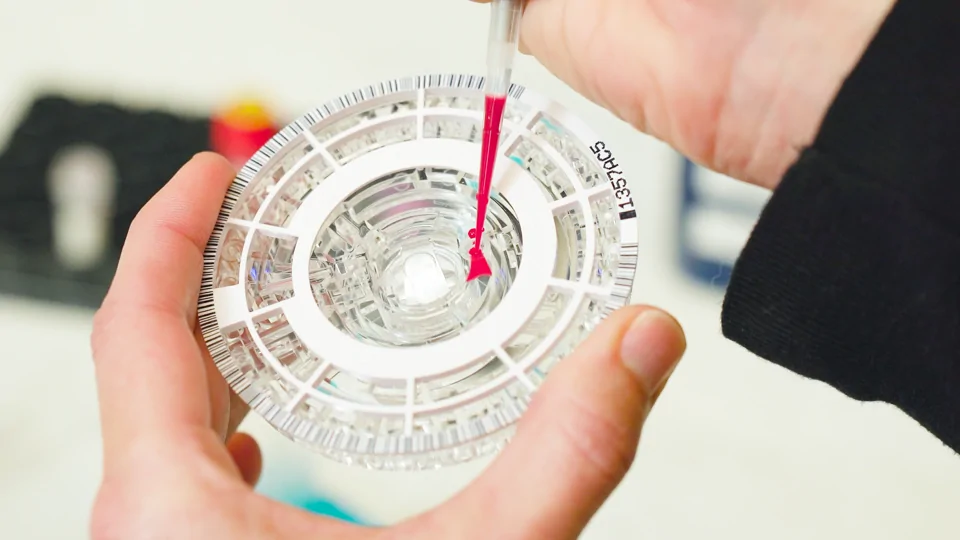
Lab screenings can detect diseases, infections, and other health issues that may be invisible to the naked eye. This is because many diseases and infections can take months or even years to manifest visible symptoms. By the time visible symptoms appear, the disease or infection may have already progressed to a more advanced stage. With lab screenings, veterinarians can detect these issues early, making it easier to treat and manage them.
Veterinary lab screenings assess your pet's overall health. They can help identify potential health risks, including cancer, diabetes, and kidney disease, which can be treated or managed more effectively if detected early. These screenings can also identify underlying issues that may not be visible during a regular physical exam. This information can help veterinarians provide more targeted and effective treatment, improving the quality of life for your pet.
If your pet has a chronic health condition, lab screenings can help monitor the progression of the condition. For example, if your pet has diabetes, regular blood tests can monitor your pet's blood sugar levels, helping to ensure that treatment is working effectively. This can help prevent complications from the condition, such as blindness or nerve damage.
Veterinary lab screenings can help prevent health issues from developing in the first place. For example, Urinary Tract Infections (UTI’S) which can be easily treated if caught early. These tests can also detect other diseases that are easily preventable with vaccines, such as parvovirus and distemper.
Perhaps the most significant benefit of veterinary lab screenings is peace of mind for pet owners. These screenings can help detect hidden health issues that may not be noticeable to the pet owner, giving them the confidence that they are doing everything possible to keep their pet healthy. Regular lab screenings can also provide a baseline of your pet's overall health, making it easier to detect changes in their health over time.
In conclusion, veterinary lab screenings are a critical part of maintaining your pet's health and wellbeing. They provide early detection of health issues, assess overall health, monitor chronic health issues, provide preventive care, and give pet owners peace of mind. We highly recommend scheduling regular veterinary lab screenings for your pet to ensure that they live a long and healthy life.
When you spay or neuter your pet, you are doing your part to reduce the overpopulation of cats and dogs in your neighborhood, with added benefits such as reduced incidence of some pet diseases, improved pet behaviors, and a longer, happier life for your pet.
You can determine the best age to spay or neuter your pet by consulting with your veterinarian, who will take your pet's species, breed, size, and lifestyle into consideration before making a recommendation.
Your pet will be placed under anesthesia, the spay/neuter procedure will be performed, and the incision will be closed with stitches, except in male cats who heal without stitches.
Your pet will be groggy post-surgery and should be confined and observed with water and half portions for a day or two. Their wound should be kept dry and your pet's activity should be restricted for 10 to 14 days post-surgery.
The primary goal of spay and neuter surgery is to reduce the overpopulation of domesticated animals. Unaltered felines can give birth to over 100 kittens in their lifetime, while female dogs can have around 70 puppies in theirs. This puts a tremendous strain on neighborhood shelters and results in large numbers of unwanted pets that have to be euthanized.
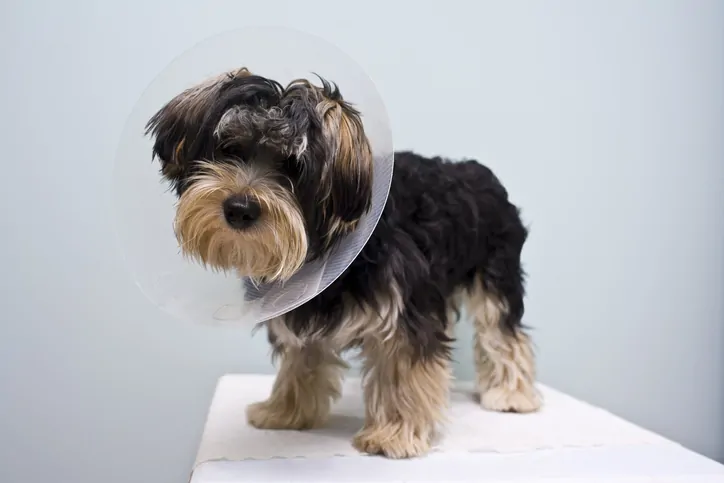
Beyond the impact that spaying and neutering have on overpopulation, spaying female pets and neutering male pets benefit their health and quality of life as well as resolve some behavior issues. Specific benefits include:
The cost of spay and neuter surgery may include vaccinations if your pet is not up-to-date, and costs vary based on your location. However, those costs are trivial compared to the cost of medical care for many litters and the price tag for treating the serious health conditions that altering your pet prevents. Some communities even offer discount spay and neuter programs to reduce the number of stray pets in their neighborhoods.
Concern about spay and neuter procedures revolves around the health risks posed by sterilizing your pet too early. Research has shown a correlation between early sterilization and a higher likelihood of some cancers, joint problems, and urinary incontinence in cats and dogs.
Early or pediatric sterilization occurs between 6 to 8 weeks of age in most breeds of cats and dogs. Standard spay and neuter procedures are performed at 5 to 9 months old. Some pet owners opt to wait until their pet goes into first heat at between 5 to 12 months of age. However, most cats are not mature until 18 months old and large breed dogs usually don't reach full maturity until 12 to 18 months old.
If you're confused about the right age to have your pet spayed or neutered, your veterinarian can provide specific recommendations based on your pet's species, size, breed, and lifestyle that also take into account your individual concerns. There are products that basically function as a chastity belt for your female pet when they are outdoors and protect them from unwanted pregnancy until you decide the time is right to have them sterilized.
Spay and neuter procedures are very safe and simple surgeries. A shot of sedatives and painkillers is administered to your pet before general anesthesia. Dogs are intubated with a breathing tube in their throat during surgery. Whereas, cats are fitted with an oxygen mask because their sterilization procedures are performed very quickly. While your pet is sedated, a machine will monitor their heart rate and oxygen level. Female dogs and cats are kept warm with a heating pad during surgery.
In spay surgery, an incision is made into the abdomen of your female pet immediately below the belly button. Through this incision, the whole reproductive tract, including the uterus and both ovaries, is removed. The incision is then closed with two layers of stitches placed beneath your pet's skin, which will eventually fall out or be absorbed by the body. Skin staples, skin glue, or stitches are some of the methods used to close your pet's skin. Spay surgery takes 15 to 20 minutes for cats and 20 to 90 minutes for dogs.
Male dogs are neutered through an incision that is made in their skin at the base of the penis close to the scrotum. This incision is used to remove both testicles. Stitches are then placed under the skin to close the wound; these stitches will eventually fall out and be absorbed by the body. Skin staples, skin glue, or stitches are also used to close the skin after your pet is neutered. Neuter surgery in dogs takes anywhere from 5 to 20 minutes.
For male cats, the testicles are removed through an incision made in the scrotum skin. The incision is not sealed with stitches, however, it will eventually close by itself. Male cats can be neutered in as little as 2 minutes.
Spay surgery is more invasive than neutering and has a longer recovery time. That being said, aftercare instructions for both spay and neuter procedures are pretty much the same. Some things you can do to help your pet recover include:
If you have any concerns about your pet's recovery, reach out to your veterinarian for further advice.
Giardia is a microscopic parasite present in tainted food, drink, and surfaces which causes gastrointestinal conditions.
The giardia strains that affect dogs and cats are not typically the same strains that affect humans, therefore, the chances of catching giardia from your pet are slim.
Giardia is most commonly transmitted through contaminated water, soil, and feces.
Giardiasis causes gastrointestinal symptoms that include gas, bloating, diarrhea, nausea, and vomiting.
Giardiasis can be treated with several prescription medications, and, in extreme cases, two medications may be combined for more effective treatment.
Giardia is a microscopic parasite that is present in tainted food, drink and soil, as well as on surfaces contaminated with infected human or animal feces. It causes giardiasis, a diarrheal disease characterized by common gastrointestinal symptoms. Pet feces can carry giardia bacteria even when the animals appear healthy. Giardia bacteria are also common in domestic animals such as cows and goats.
The giardia strains that affect dogs and cats are not the same strains that affect humans, so, the chances of catching giardia from your pet are slim. Even so, giardia is contagious as it can pass from person to person with ease. However, if you have exotic animals, ask your veterinarian if your pet is susceptible to zoonotic giardia. Zoonotic giardia is any strain of giardia that can spread between humans and animals and is prevalent in chinchillas, beavers, opossums, monkeys, and birds as well as goats, cows, and other domesticated animals.
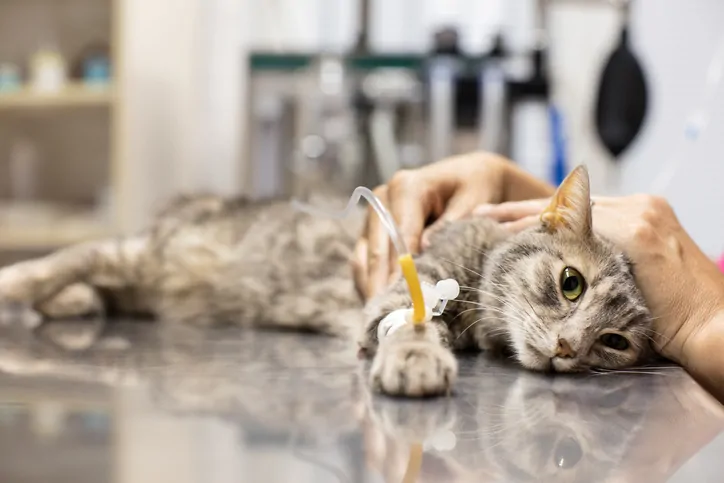
Giardia infections can cause a range of gastrointestinal symptoms in humans, pets, and other animals, but it is possible to exhibit no signs of illness. Common giardia symptoms include:
Untreated giardiasis can evolve into a chronic gastrointestinal illness or result in dehydration, malnutrition, poor overall health, and even death.
According to a 2006 study by the College of Veterinary Medicine and Cornell University (and other collaborators), the average prevalence of giardia infection in pets nationwide was 15.85% for dogs and 10.37% in cats. Cats and dogs in the Northeastern U.S. had the highest prevalence rates while cats and dogs in the Southeast had the lowest. The study represented populations that were owned and well-cared for. Sheltered and feral populations are assumed to have higher prevalence rates, and puppies and kittens are more susceptible to complications from giardiasis than adult dogs and cats. Giardia is transmitted to cats and dogs in several ways including:
Giardia is present worldwide and has been included in the WHO's Neglected Disease Initiative. Human giardiasis infection is most prevalent in under-developed countries with poor water treatment and sanitary conditions at rates as high as 20-40% of the population with the highest incidence among children under 5 years of age. In developed countries, giardiasis rates range between 2% and 7%. Humans may also contract giardia from contaminated water sources as well as from poor hygiene while handling food, changing infected baby diapers, and close personal contact including high-risk sexual activity.
Giardiasis is diagnosed by a fecal test, whether the patient is a pet, domesticated animal, or human. The volume of giardia being passed in the stool changes from day to day and may be too low to identify from any one sample, necessitating the testing of many stool samples. Consequently, a doctor treating a human patient with uncertain infection status may order the enzyme-linked immunosorbent assay, or ELISA test, which is a more accurate test. Less frequently, doctors will use an endoscope to examine the small intestine's lining and take samples from the gut to be tested in a lab. When a definitive cause of diarrhea hasn't been identified, this is done in more severe situations.
There are no approved over-the-counter treatments or home remedies available for giardiasis. Fenbendazole and metronidazole are the two medications that are most used for giardia in dogs, cats, and other animals. To treat severe giardiasis, these medications are often used for three to ten days and, if necessary, the two medications may be administered together. There are several medications that can be used to treat giardia infections in humans including metronidazole, tinidazole, and nitazoxanide.
Providing your pet with safe, clean drinking water is the strongest defense against giardia infection. It's crucial to prevent dogs from drinking water that has been contaminated by the feces of other animals.
Giardia can spread through surfaces and direct touch, so it's important to keep the spaces under your control generally clean and hygienic. This entails cleaning up your pet's excrement and cleaning up any toys, pet beds, your hands, and other surfaces that they come into touch with. High pet traffic areas, such as parks or daycare facilities, may increase your pet's risk of contracting the parasite.
Try to keep an eye out for activities that could raise their chance of being sick, including drinking from puddles or sniffing other animals' feces. If your dog leaves feces on the ground, pick it up and dispose of it right away to stop the spread of giardia. Use gloves, a sack over your hand, or a scooping device to protect yourself from coming into contact with feces.
Vomiting occurs in dogs as a response to digestive indiscretions, food sensitivities or allergies, infections, digestive tract blockage, and other underlying conditions.
Vomiting is the ejection of the contents of the stomach and upper intestines, while regurgitation is the expulsion of food and other contents from the esophagus.
Vomiting frequently occurs in conjunction with diarrhea, gas, and bloating in dogs and can lead to dehydration, electrolyte imbalances, and occasionally death.
Vomiting in dogs may be treated with short fasts, bland diets, fluid therapy, prescription medications, and in serious cases, surgical intervention.
Vomiting is a messy symptom of gastrointestinal distress in dogs that many dog guardians face and that may cause serious complications for your pup. That's why it's important to seek veterinary attention for your furry family member as quickly as possible when you are unsure why your dog is throwing up.
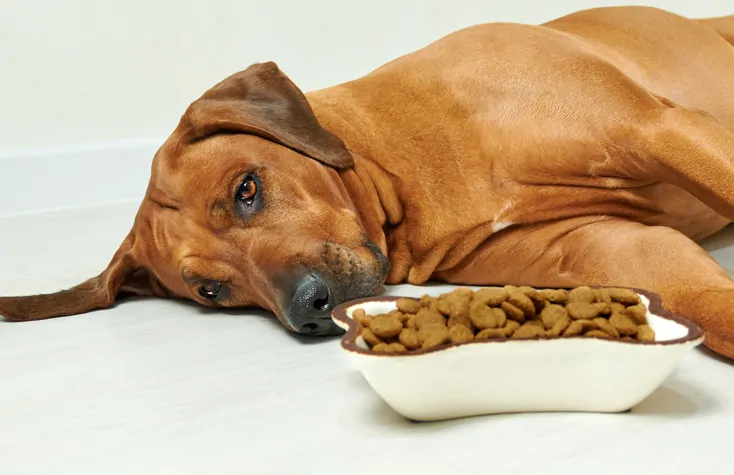
Some illnesses that resemble vomiting could be caused by a different condition. Active retching or heaving along with throwing up food or bile are indicators that vomiting is your dog's issue. Liquids, mucus, or white or yellow foam may also be visible.
On the other hand, regurgitation is more likely if your dog is bringing up food they've recently eaten, particularly if it's undigested food and there isn't any heaving, retching, or gagging involved, instead the food seems to pop out unexpectedly.
Regurgitation is the expulsion of the contents of the esophagus, whereas vomiting is the ejection of the contents of the stomach and upper intestine. A violent cough can also resemble vomiting in both appearance and sound; some canine coughs even produce foam.
Vomiting, regurgitation, and coughing all have unique causes and hence require unique treatments, though the distinctions can be slight. Any observations you make will therefore aid your veterinarian in making an accurate diagnosis.
There are multitudes of diverse reasons why your dog may be vomiting. Some of the most common causes of vomiting in dogs include:
Fortunately, most occurrences of vomiting in healthy dogs may be quickly and effectively treated. Sometimes, however, your dog's vomiting may be a symptom of a dangerous or even fatal underlying condition. If your pet develops any of these signs, you should take them to the vet right away:
Check your dog for dehydration by looking for dry or pale gums and "tenting" on the skin. You can check for tenting by pulling up on the skin between your dog's shoulder blades and observing how it settles back down. Your pup is likely dehydrated if it continues to stand up like a tent.
The underlying cause of vomiting in your dog will determine the course of treatment. To rule out a foreign body, an underlying ailment, or other problem, your veterinarian may want laboratory tests or X-rays in addition to a physical examination.
These diagnostics assist your vet in identifying the source problem more, avoiding harmful complications, and providing more effective, and often, less expensive treatment.
Here are a few typical treatments for the majority of conditions that cause vomiting in dogs:
Do not administer any human drugs or over-the-counter medications to dogs without first seeing your veterinarian.
You can reduce your dog's risk of developing conditions that cause vomiting by:
These suggestions may be helpful in preventing other health issues as well. If your pet vomits three or more times in an eight-hour period or has other concerning symptoms, don't hesitate to get vet help right away, as some conditions which cause vomiting in dogs can be life-threatening and time-sensitive.
When you bring home a new kitten, you should prepare a small, comfy area from which to explore their new home, schedule a vet visit within two weeks, socialize your kitten, feed them high-quality food, engage them in daily play, and spay or neuter your kitten around six months old.
Your kitten's vital signs will be checked, a complete examination will be performed, and your veterinarian will recommend vaccines, wormers, and other aides, such as microchips, that suit your kitten's lifestyle.
Kittens are usually eligible to be spayed or neutered at about six months of age (the timing is critical to prevent mammary tumors in females and spraying in males).
Kittens are comparatively low-maintence, polite, graceful, independent, and clean housemates. But did you know they also have healing powers?
Your kitten possesses a very particular set of health benefits that you don't find in other animals. The vibrations from your kitten's purr, for example, assist with bone healing and migraines as well as decreasing blood pressure, reducing osteoporosis, and increasing your chances of surviving a heart attack. Petting your kitten has also been shown to release oxytocin, "the love hormone."
They can also teach you a lot about healthy relationships because cats offer unconditional love, have respect for personal space, and inspire their owners to be more patient and caring towards others. Kittens aren't very needy but they do require care to enjoy a long and healthy life. Here we will provide the particulars of raising a kitten.

Kitten-proofing should be done before your new kitty actually arrives at your home. Some plants are toxic to cats and should be positioned out of the reach of kittens because they tend to consume them. But, the majority of plants irritate their stomach when consumed.
Similar to childproofing a house, breakables should be out of your kitten's reach, garbage can lids should be covered, blind cords should be wrapped, and window screens should be properly fastened. Additionally, since some kittens genuinely enjoy eating certain materials, store thread, plastic, elastic bands, and paper, away from your kitten's reach. Shrewd kitties often figure out how to access cupboards and cabinets, in which case, baby locks may be utilized to prevent them.
Your kitten will feel more at ease if you keep them in a smaller section of the house while they get used to their new surroundings. Kittens start to explore their new territory as they become more comfortable. Feliway, a natural cat pheromone that comes in a spray or diffusible oil, calms kittens during this transition.
Every kitten needs a thorough, head-to-tail, checkup a couple of weeks after coming home to ensure that everything is in good order. Your kitten's vital signs will be checked and a complete examination will be performed as well as any lab tests your vet considers necessary. Your veterinarian will also ask questions about your kitten's lifestyle to inform their recommendations as to which vaccines, wormers, and other aides, such as microchips, will be helpful in your kitty's case. Common kitten viruses that require vaccinations include:
Vaccine reactions in kittens are rarely severe and often clear on their own. Possible side effects include pain and swelling at the injection site, lethargy, and mild fever. If your kitten develops facial swelling, hives, diarrhea, or difficulty breathing, return to your veterinary office immediately. Your kitty may also be tested for worms, but will likely be given deworming medications regardless of the result since parasites are so common in kittens. Your kitten should be rechecked for worms at six months of age.
It's vital to your kitten's health that they be fed according to their "life stage." Kittens should be fed high-quality kitten food until they are one year old. High-quality cat food will list a protein source as its first ingredient.
Your vet can determine your cat's body condition score (BCS) to help guide your kitten's diet plan. Canned food is considered best for your kitten and a mix of dry and canned food is best for their teeth. Food can be left out for a kitten's first six months of life, but after that point, most cats need to start using some type of portion control to prevent obesity, which is a major issue for many cats.
Kittens will be vulnerable to dehydration throughout their lives, so it's good to scatter water bowls around the house to encourage them to drink.
It's crucial to get your cat used to being handled and held by others during the first few months. Offer a kitten cuddle to friends and family to help socialize your kitty.
Your vet will demonstrate how to handle your kitten's feet, trim their nails, clean their ears, brush their coat, and properly brush their teeth on their initial visit to the veterinarian. Treats can be given as an incentive to encourage positive behavior.
Additionally, if your kitten carrier is kept outside, your kitty may become accustomed to its presence and feel at ease playing or resting in it. The chances of getting your kitten inside a carrier without a fuss increase if your kitty doesn't exclusively associate their carrier with trips to the veterinarian.
Play is part of your kitten's everyday routine. Don't allow your kitten to play with any of your body parts, however how harmless it might seem. If your kitty tries to bite your fingers or bite your toes, you should ignore them and divert their attention with a suitable toy. Kittens become excited by any response, even one that is critical, and will be motivated to keep trying.
Offer plenty of horizontal and vertical scratching posts and a variety of toys to keep your kitten amused. Kitties who play vigorously are likely to sleep a lot in between play sessions. Play with them earlier in the evening to tire them out before bedtime and prevent their nightly shenanigans from conflicting with your overnight sleep.
Spaying or neutering reduces the number of stray cats that have to be euthanized in your community. Kittens are usually eligible for the procedure at about six months of age (the timing is critical to prevent mammary tumors in females and spraying in males). Prior to spaying/neutering surgery, baseline/pre-surgical blood is typically taken to confirm that your kitten is a safe candidate for anesthesia and to give a baseline against which future results can be compared. This also double-checks your kitten's virus status. Their electrolytes, blood sugar, white and red blood cell counts, and kidneys will all be examined before surgery. Your vet will provide detailed after-care instructions.
Worms are primarily transmitted to dogs through their mother's placenta, contaminated soil and fleas.
The most common types of worms in dogs are hookworms, roundworms, whipworms, heartworms, and tapeworms.
Common symptoms of worms in dogs include weight loss, fatigue, gastrointestinal distress, distended stomach, and visible worms in feces.
Intestinal worms are treated with deworming medications while heartworms are treated with a series of injections.
Keeping your canine worm-free is a common challenge that most dog owners face. Worms cause serious health problems for dogs if left untreated so responsible dog owners take special care to understand the dangers, symptoms, and available treatments for canine worms.

Worm larvae and eggs are very difficult to see, and by the time you see adult worms, they are already a problem. Therefore, it's important to know where worms come from to begin with:
Dogs are most commonly infected with hookworms, roundworms, whipworms, heartworms, and tapeworms. Hookworms fasten themselves to dogs' small intestines, suck their blood, and cause anemia, which is potentially fatal to puppies. Small roundworm larvae are present in a large percentage of newborn puppies but can grow to be several inches long and can cause potentially-fatal intestinal blockages. Whipworms cause few symptoms and live in dogs' small intestines, where they produce eggs that can survive in the soil for years. Heartworms are foot-long worms that dwell in the heart, lungs, and arteries of infected dogs and can lead to severe lung disease, heart failure, and harm to other organs. Tapeworms are flat, segmented worms that transfer to dogs through ingested fleas, cause mild symptoms, and can grow up to two feet in length.
The best way to know if your dog has worms is to have your veterinarian conduct a fecal exam. You may, but, keep an eye out for certain symptoms and indicators at home that could indicate your dog has worms.
While tapeworms are visible in your dog's stool, other intestinal worms usually have to be identified through microscopic inspection of a stool sample to look for eggs. It is advisable to give your vet a stool sample when your dog is getting his annual checkup, even if there are no symptoms. A blood test can usually identify heartworms, but, a radiograph, ultrasound, or echocardiograph may be necessary in rare circumstances. Many dogs with heartworm disease in its early stages exhibit few or no symptoms, but the earlier treatment begins, the higher the success rate. Therefore, it is a good idea to test heartworms on a yearly basis.
Deworming medications come in a variety of forms that can prevent and treat intestinal parasites. These can be given via injection, pill, or topical application. When using pet store items, make sure you are giving the right dosage for your dog's body weight and that you are aware of the types of worms that each treatment is effective against. A single treatment of dewormer may also be insufficient to eradicate all worms from your dog's body. Fresh larvae can enter the intestine following deworming so more treatment may be required to eradicate the illness. Additionally, routine deworming is not always enough to stop mothers from spreading worms to their offspring, as a result, special medications may be needed. Dogs that are infected with heartworms need a special series of injections because intestinal dewormers are not effective for heartworms.
The best practice for most dog owners is to administer a worm preventative to your pet year-round. In fact, a dewormer for intestinal parasites is contained in many heartworm prevention treatments. Based on the worms present in your area of the country and the life style your dog leads, your veterinarian will advise you on the best course of action. There are also several actions you can do in addition to drugs to avoid worm infestations:
Preventing worms in dogs also protects dog owners. When worms are present in your environment, they are easier to catch than you may realize. Dog owners can be infected with worms by handling puppies and kittens, coming in contact with contaminated soil, cleaning up pet waste, or ingesting infected fleas when sleeping or playing with their dogs. You can reduce your risk of catching worms from your dog by wearing gloves, using a bag to collect feces, and keeping your lawn and garden clear of dog waste.
A mass is a lump that occurs directly under, inside, or on your pets skin caused by abnormal cell growth, immune reactions, hormonal changes, or a cyst.
If you find a mass on your pet, take a picture of it, measure it, watch it for changes, and call your vet.
Masses are diagnosed through fine needle aspiration but further diagnostic test may also be performed including surgical biopsy, x-ray, ultrasound, and MRI.
Your pet will be put under anesthesia, the mass will be removed, sutures are used to close the incision, and the mass may be sent to the lab for further testing.
Your pet should recover in a comfortable spot, possibly fitted with an Elizabethan collar, and be prevented from jumping, climbing, and intense activity.
Aging pets often get masses or growths under their skin and they are usually nothing to worry about. Still, it's an unpleasant surprise to find one when you are stroking your pet's fur. A mass is a lump that occurs under, inside, or on top of your pet's skin, and can be caused by an abnormal growth of cells, immune reactions, hormonal changes, or a cyst. Some common masses that occur on pets include benign tumors such as lipomas, skin tags, or cysts. Less often, the mass is malignant such as with mammary tumors, squamous cell carcinomas, osteosarcomas, mast cell tumors, and lymphomas.

Even though most lumps you find on your pet will not need treatment unless they become irritated or inflamed, even the smallest chance of cancer is too much to ignore. So, it's important to investigate the cause of any mass you find on your pet. Here are some steps you should take when you notice a growth in your pet.
At your pet's appointment, your veterinarian will determine what the mass is made of using a type of biopsy called fine needle aspiration. The process requires that a needle be inserted into your pet's mass so that a cell sample may be taken from it. Your veterinarian can determine whether it is cancerous by looking at it under a microscope.
If a malignant tumor is discovered, your vet may advise "staging" your pet, which could entail a surgical biopsy, x-rays, ultrasound, or MRI to see if cancer has spread to other parts of their body before surgical removal. If cancer has not spread from the mass, your vet will want to remove it as quickly as possible before the mass has a chance to spread. If cancer has spread, simply removing the mass wouldn't cure cancer, so other treatment options such as chemotherapy and radiation, or even experimental treatments and alternative therapies may be explored in addition to mass removal.
If your pet only needs mass removal, that is very good news. It means that, with surgery, aftercare, and close observation, your pet has an excellent chance at a happy outcome.
Your pet will be anesthetized for their mass removal surgery. While your pet is under anesthesia, their oxygen levels, pulse, blood pressure, respiration, heart rate, and body temperature will be closely monitored.
The tumorous mass may be removed by electrocautery, a surgical procedure that uses an electric current to heat a metal wire electrode that destroys abnormal tissue and can be used to control bleeding during surgery. Once the tumorous tissue is removed, the incision will be closed with sutures that will either be absorbed by your pet's body as they heal or have to be removed by your vet at a later date.
Veterinarians often recommend that the mass be submitted to a diagnostic laboratory after it is removed for further testing that can identify the exact type of cancer that caused the mass and determine the margins of mass removal, which indicate whether the mass was completely removed during surgery. Your vet may make further treatment recommendations based on the laboratory results.
It's typical for your pet to feel a little lethargic for a day or two after surgery. Call your veterinarian if your dog or cat appears to be in discomfort. They might be able to recommend a medication to lessen the pain.
In order to ensure that your pet heals and recovers as quickly as possible after the mass removal procedure, it is imperative that you heed all your veterinarian's aftercare instructions. Giving your recovering pet a place to relax, using an Elizabethan collar if necessary, and preventing them from climbing, jumping, and doing intense activities following the surgery will help aid their recovery. Some issues to watch for post-surgery include:
If you notice any of these issues or have any other concerns about how your pet is recovering, seek further advice from your veterinarian.
Phone: (855) 461-8259
Email: [email protected]